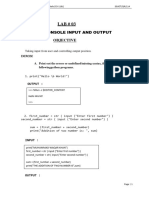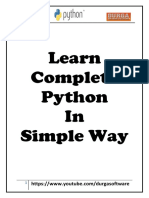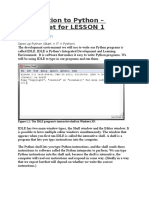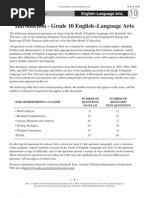Python LAB 03
Uploaded by
Amna saeedPython LAB 03
Uploaded by
Amna saeedProgramming Fundamentals (CS-116L) SSUET/QR/114
LAB # 03
CONSOLE INPUT AND OUTPUT
OBJECTIVE
Taking input from user and controlling output position.
THEORY
Console I/O Functions
The keyboard and visual display unit (VDU) together are called a console. Python
programming language provides many built-in functions to read any given input and to
display data on screen, Console (also called Shell) is basically a command line
interpreter that takes input from the user i.e one command at a time and interprets it. If
it is error free then it runs the command and gives required output otherwise shows the
error message.
Accepting Input from Console
To take input from the user we make use of a built-in function input().
Syntax : input(prompt)
Displaying Input from Console
The print( ) function prints the specified message to the screen, or other standard output
device.
The message can be a string, or any other object, the object will be converted into a
string before written to the screen.
Syntax: print(object(s), separator=separator, end=end, file=file, flush=flush)
Example:
name=input('Please enter your name: "') print("Hello,
" , name , "!")
Output:
>>> %Run task1.py Please enter your
name:ABC Hello, ABC!
>>>
Lab 03: Console Input and Output 1
Programming Fundamentals (CS-116L) SSUET/QR/114
Whatever you enter as input, input function convert it into a string. if you enter an
integer value still input() function convert it into a string. You need to explicitly convert
it into an integer in your code using typecasting.
Example:
# Program to check input
num = input ("Enter number :")
print(num)
name1 = input("Enter name : ")
print(name1)
# Printing type of input value
print ("type of number",type(num))
print ("type of name",type(name1))
We can also type cast this input to integer, float or string by specifying the input()
function inside the type.
Typecasting the input to Integer/Float: There might be conditions when you might
require integer input from user/console, the following code takes two
input(integer/float) from console and typecasts them to integer then prints the sum.
Example
# input num1 =
int(input()) num2
= int(input())
# printing the sum in integer
print(num1 + num2)
Escape Sequence
In Python strings, the backslash "\" is a special character, also called the "escape"
character. An escape sequence is a sequence of characters that does not represent itself
when used inside a character or string literal, but is translated into another character or
a sequence of characters that may be difficult or impossible to represent directly.
Escape Description
Example Output
Sequence
\\ Prints Backslash print ("\\") \
\` Prints single-quote print ("\'") '
\" Pirnts double quote print ("\"") "
print hello
\n ASCII linefeed ( LF )
("hello\nworld") world
\b ASCII backspace ( BS ) removes print ("az" + "\b" ac
Lab 03: Console Input and Output 2
Programming Fundamentals (CS-116L) SSUET/QR/114
previous character + "c")
ASCII horizontal tab (TAB). Prints
\t print ("\t*hello") *hello
TAB
EXERCISE
A. Point out the errors or undefined/missing syntax, if any, in the following python
programs.
1. print("Hello \b World!")
2. first_number = str (input ("Enter first number") )
second_number = str (input ("Enter second number") )
sum = (first_number + second_number)
print("Addition of two number is: ", sum)
3. age = 23
message = "Happy " + age + "rd Birthday!"
print(message)
B. What would be the output of the following programs:
1. a=5
print("a =", a, sep='0', end=',')
Lab 03: Console Input and Output 3
Programming Fundamentals (CS-116L) SSUET/QR/114
2. name = input("Enter Employee Name")
salary = input("Enter salary")
company = input ("Enter Company name")
print("Printing Employee Details")
print ("Name", "Salary", "Company")
print (name, salary, company)
3. n1=int(input('"enter n1 value'))
n2=int(input('enter n2 value'))
C. Write Python programs for the following:
1. Write a program to print a student’s bio data having his/her Date of birth, Roll no,
Section, Percentage and grade of matriculation and Intermediate. All the fields
should be entered from the console at run time.
2. Write a program that asks the user what kind of food they would like. Print a
message about that food, such as “Let me see if I can find you a Chowmein”. Food
name must be in uppercase.
(hint: use upper( ) for food name)
3. Take the marks of 5 courses from the user and calculate the average and percentage,
display the result:
Eachcourse=50 marks
Lab 03: Console Input and Output 4
Programming Fundamentals (CS-116L) SSUET/QR/114
Total_marks= course1+course2+course3+course4+course5
average=Total_marks/5
percentage=(Total_marks x 100)/250
Lab 03: Console Input and Output 5
You might also like
- At The Heart of The Gospel Suffering in The Earliest Christian Message100% (1)At The Heart of The Gospel Suffering in The Earliest Christian Message172 pages
- Beel 1234 Lab 1 - Introduction To Python ProgrammingNo ratings yetBeel 1234 Lab 1 - Introduction To Python Programming10 pages
- Introduction To Programming With PythonNo ratings yetIntroduction To Programming With Python34 pages
- 2_1_Console IO, Variables, Data Types (1)No ratings yet2_1_Console IO, Variables, Data Types (1)40 pages
- What Is Python?: Emphasis On Structure and Discipline Simple Problems ! Simple ProgramsNo ratings yetWhat Is Python?: Emphasis On Structure and Discipline Simple Problems ! Simple Programs27 pages
- Stored Programs: Mastering Cyberspace: An Introduction To Practical ComputingNo ratings yetStored Programs: Mastering Cyberspace: An Introduction To Practical Computing9 pages
- 11 Computer Science Notes Unit1 Python Prog SimpledatatypeNo ratings yet11 Computer Science Notes Unit1 Python Prog Simpledatatype4 pages
- Beginning Programming With Python For Dummies (Mueller 2014-09-22)No ratings yetBeginning Programming With Python For Dummies (Mueller 2014-09-22)34 pages
- 4 - Input-Output, Keywords and IdentifiersNo ratings yet4 - Input-Output, Keywords and Identifiers27 pages
- 4 - Input-Output, Keywords and IdentifiersNo ratings yet4 - Input-Output, Keywords and Identifiers30 pages
- Integer Division: When We Divide Integers With /, The Quotient Is Also An IntegerNo ratings yetInteger Division: When We Divide Integers With /, The Quotient Is Also An Integer20 pages
- Keyboard - Arrow - Down Keyboard - Arrow - Down Keyboard - Arrow - Down: Expand - MoreNo ratings yetKeyboard - Arrow - Down Keyboard - Arrow - Down Keyboard - Arrow - Down: Expand - More6 pages
- Python Notes by Rishabh Mishra Chap-07-Input FunctionNo ratings yetPython Notes by Rishabh Mishra Chap-07-Input Function3 pages
- Introduction to Python Programming: Do your first steps into programming with pythonFrom EverandIntroduction to Python Programming: Do your first steps into programming with pythonNo ratings yet
- The Impact of Using Video in Developing PDF100% (1)The Impact of Using Video in Developing PDF7 pages
- Name: - Date - Verb To Be Obs and OccupationsNo ratings yetName: - Date - Verb To Be Obs and Occupations2 pages
- Video, Audio Dan Teks Kosakata Bahasa Inggris UmumNo ratings yetVideo, Audio Dan Teks Kosakata Bahasa Inggris Umum3 pages
- Ss 2 Literature-In-English Second Term (New)No ratings yetSs 2 Literature-In-English Second Term (New)51 pages
- Aops Community Russian TST 2016: Days 1-6 Day 7 P1No ratings yetAops Community Russian TST 2016: Days 1-6 Day 7 P16 pages
- AI Detector - Trusted AI Checker for ChatGPT, GPT4 & GeminiNo ratings yetAI Detector - Trusted AI Checker for ChatGPT, GPT4 & Gemini1 page
- Literature in English Test: Practice BookNo ratings yetLiterature in English Test: Practice Book84 pages
- European Journal of Theoretical and Applied SciencesNo ratings yetEuropean Journal of Theoretical and Applied Sciences12 pages
- FS-Maths-Literacy-Grade-12-June-2023-P2-and-MemoNo ratings yetFS-Maths-Literacy-Grade-12-June-2023-P2-and-Memo26 pages
- CLEVO P670HP6 (-G) P671HP6 (-G) (P670HP6 Skylake) 6-71-P65P0-D02ANo ratings yetCLEVO P670HP6 (-G) P671HP6 (-G) (P670HP6 Skylake) 6-71-P65P0-D02A92 pages
- Lab 04 - Installing and Configuring WS ServicesNo ratings yetLab 04 - Installing and Configuring WS Services7 pages
- EDITED FLAT FILIPINO Analysis and Interpretation of Pre and Post TestNo ratings yetEDITED FLAT FILIPINO Analysis and Interpretation of Pre and Post Test8 pages
- 1950 Criminal Law and Procedure in Nepal A Century Ago - Hodgson by Adam in Far Eastern Quarterly SNo ratings yet1950 Criminal Law and Procedure in Nepal A Century Ago - Hodgson by Adam in Far Eastern Quarterly S23 pages
- At The Heart of The Gospel Suffering in The Earliest Christian MessageAt The Heart of The Gospel Suffering in The Earliest Christian Message
- Beel 1234 Lab 1 - Introduction To Python ProgrammingBeel 1234 Lab 1 - Introduction To Python Programming
- What Is Python?: Emphasis On Structure and Discipline Simple Problems ! Simple ProgramsWhat Is Python?: Emphasis On Structure and Discipline Simple Problems ! Simple Programs
- Stored Programs: Mastering Cyberspace: An Introduction To Practical ComputingStored Programs: Mastering Cyberspace: An Introduction To Practical Computing
- 11 Computer Science Notes Unit1 Python Prog Simpledatatype11 Computer Science Notes Unit1 Python Prog Simpledatatype
- Beginning Programming With Python For Dummies (Mueller 2014-09-22)Beginning Programming With Python For Dummies (Mueller 2014-09-22)
- Integer Division: When We Divide Integers With /, The Quotient Is Also An IntegerInteger Division: When We Divide Integers With /, The Quotient Is Also An Integer
- Keyboard - Arrow - Down Keyboard - Arrow - Down Keyboard - Arrow - Down: Expand - MoreKeyboard - Arrow - Down Keyboard - Arrow - Down Keyboard - Arrow - Down: Expand - More
- Python Notes by Rishabh Mishra Chap-07-Input FunctionPython Notes by Rishabh Mishra Chap-07-Input Function
- Computer Engineering Laboratory Solution PrimerFrom EverandComputer Engineering Laboratory Solution Primer
- Introduction to Python Programming: Do your first steps into programming with pythonFrom EverandIntroduction to Python Programming: Do your first steps into programming with python
- Video, Audio Dan Teks Kosakata Bahasa Inggris UmumVideo, Audio Dan Teks Kosakata Bahasa Inggris Umum
- Aops Community Russian TST 2016: Days 1-6 Day 7 P1Aops Community Russian TST 2016: Days 1-6 Day 7 P1
- AI Detector - Trusted AI Checker for ChatGPT, GPT4 & GeminiAI Detector - Trusted AI Checker for ChatGPT, GPT4 & Gemini
- European Journal of Theoretical and Applied SciencesEuropean Journal of Theoretical and Applied Sciences
- CLEVO P670HP6 (-G) P671HP6 (-G) (P670HP6 Skylake) 6-71-P65P0-D02ACLEVO P670HP6 (-G) P671HP6 (-G) (P670HP6 Skylake) 6-71-P65P0-D02A
- EDITED FLAT FILIPINO Analysis and Interpretation of Pre and Post TestEDITED FLAT FILIPINO Analysis and Interpretation of Pre and Post Test
- 1950 Criminal Law and Procedure in Nepal A Century Ago - Hodgson by Adam in Far Eastern Quarterly S1950 Criminal Law and Procedure in Nepal A Century Ago - Hodgson by Adam in Far Eastern Quarterly S

























































































